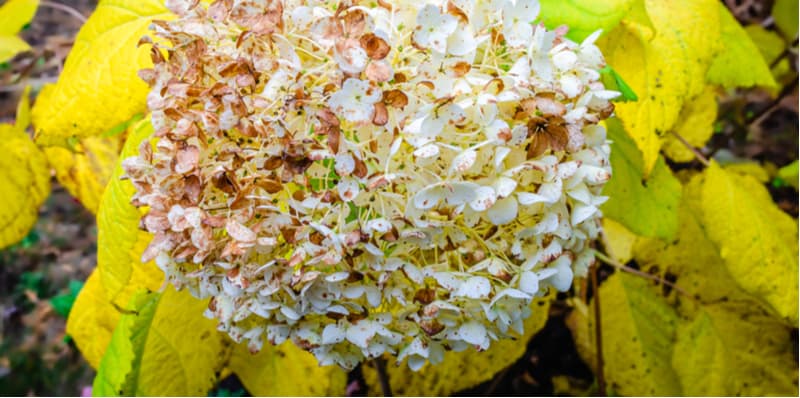The Basic Principles Of Hydrangea Leaves Turning Yellow
The Basic Principles Of Hydrangea Leaves Turning Yellow
Blog Article
How Hydrangea Leaves Turning Yellow can Save You Time, Stress, and Money.
Table of ContentsThings about Hydrangea Leaves Turning YellowHydrangea Leaves Turning Yellow for BeginnersHydrangea Leaves Turning Yellow Things To Know Before You Get ThisThe Best Guide To Hydrangea Leaves Turning Yellow
Hydrangea plants are known for their beautiful blossoms, yet sometimes their leaves can turn yellow. This is normally an indication that something is wrong and the plant requires your help. There are numerous possible reasons for yellow leaves on Hydrangeas, and thankfully the majority of them are very easy to deal with. Below we'll cover the most common reasons of Hydrangea leaves turning yellow and how to repair them.Hydrangea leaves turning yellow can be a reason for problem. Hydrangea leaves typically turn yellow when the plant is overwatered.
When the roots of a plant are submerged in water for extended periods, they begin to suffocate and rot. This procedure cuts off the roots' oxygen supply, creating the fallen leaves to transform yellow and at some point die. Overwatering can additionally lead to various other troubles such as leaf decrease, origin damages, and fungal development.
If you think your Hydrangea is overwatered, the very best remedy is to let the soil dry completely before watering again. It's also a great concept to inspect the drainage of your pot or yard bed and make certain that water is not pooling around the plant's roots. Hydrangea plants require well-drained soil to prosper.
The Definitive Guide to Hydrangea Leaves Turning Yellow
You must additionally guarantee that you are not sprinkling your Hydrangea too commonly. Watering when a week need to suffice, and a lot more commonly if the climate is hot and completely dry. Hydrangea leaves can additionally transform yellow if the plant is not obtaining enough water. This takes place when the plant does not get sufficient water, and the soil starts to dry out.

This is referred to as "fertilizer burn," It takes place when the plant's origins are exposed to too much fertilizer. The origins can not soak up all of the nutrients and become damaged. This damages causes the fallen leaves to transform yellow and eventually pass away. Other indicators of plant food melt consist of brown or yellow fallen leaves, wilting, and stunted development.
This will aid remove any kind of excess plant food from the roots of the plant. It's likewise a great concept to lower the amount of plant food you are using.
The 20-Second Trick For Hydrangea Leaves Turning Yellow

If your Hydrangea is infested with insects, dealing with the plant with neem or horticultural oil is the finest solution. It's likewise excellent to get rid of any damaged leaves from the plant (Hydrangea Leaves Turning Yellow).
Hydrangea leaves can also transform yellow if the temperature stresses the plant. The leaves of the plant will certainly turn yellow and start to drop off.
If the temperature stresses your Hydrangea, you require to relocate the plant to an area where it will be protected from the severe chilly or warmth. You can additionally attempt to provide the plant with some partial shade if subjected to guide sunshine. You can also try including compost around the plant base to help control the temperature level.
5 Easy Facts About Hydrangea Leaves Turning Yellow Shown
The fallen leaves can also turn yellow if the Hydrangea plant has root rot. This is usually triggered by overwatering or poor water drainage. When the plant's roots are submerged in water for too long, they start to rot. Among the most typical origin rot symptoms is yellowing fallen leaves, as the fungi prevents the origins from absorbing nutrients from the dirt.
Other indicators of origin rot include stunted growth, wilting, and fallen leave decline. Examine the roots of your Hydrangea if it has root rot. If they are black or brownish, after that they are probably rotten. If some healthy and balanced origins are left, you can attempt to save the plant by replanting it in a brand-new pot with fresh soil.
Water the plant meticulously, ensuring not to overwater it. If your Hydrangea is greatly influenced by root rot, starting with a brand-new plant is best. All-natural reasons can also trigger yellow hydrangea leaves. The most common reason is the plant's age. As Hydrangeas age, their leaves will gradually turn yellow and brown Check This Out before diminishing the plant.
You can help the plant by guaranteeing it is obtaining sufficient water and nutrients. You can additionally mulch around the plant base to assist this link it keep dampness. There are a number of reasons hydrangea leaves could turn yellow and diminish. Hydrangea Leaves Turning Yellow. One opportunity is that the plant is not obtaining enough water.
Report this page